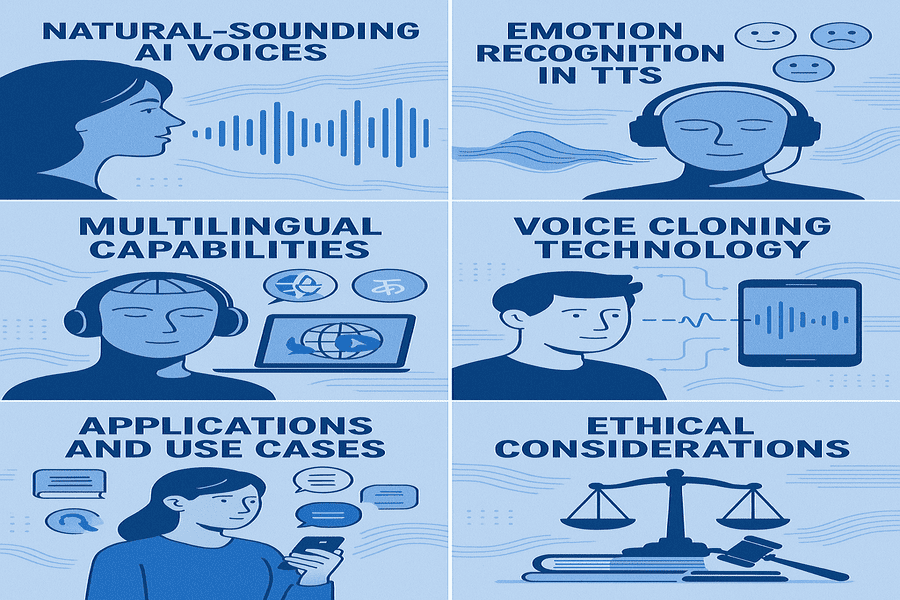
The future trends in text to speech industry will bring voices that sound almost identical to humans, with natural emotions and speaking patterns that make them feel real. AI voices will soon express excitement, sadness, or calmness based on what they’re saying. Systems will easily switch between dozens of languages without losing quality. Voice cloning will need just seconds of someone talking to make a voice that sounds exactly like them. These improvements will make technology easier for everyone to use and change how we talk to our devices every day.

The Technology Revolution Behind Modern Text-to-Speech (TTS)
The world of speech synthesis has completely changed in the last few years. Remember those robot-sounding computer voices? They’re being replaced by neural TTS systems that sound much more like real people talking.
What changed everything? It’s mostly thanks to deep learning – basically teaching computers to listen to thousands of hours of people talking and figure out what makes speech sound natural. This new approach has totally changed how we make synthetic speech.
Key Breakthroughs in Modern AI Voice Technology
The biggest improvements in text-to-speech (TTS) lately include:
- Neural network models – These smart AI systems listen to real people talking and learn all the tiny details – like how our voices go up at the end of questions or how we slow down for important points – that make speech sound human instead of robotic.
- Voice cloning technology – New systems can copy someone’s voice using just 6 seconds of them talking. That’s a huge improvement from the old days when you needed hours of recordings.
- Emotion detection and expression – The newest AI-powered TTS engines can figure out the feeling behind the words and make the voice sound happy, sad, or serious when it needs to.
- Multilingual capabilities – Top systems now handle tons of languages and can even clone voices across different languages, helping content reach people worldwide.
These technologies work together to create realistic AI voices that are changing how we interact with our devices and digital content.
Market Growth and Business Impact
The future trends in text to speech industry looks extremely promising from a business perspective. Market reports consistently show strong growth ahead, with the global text-to-speech market expected to reach approximately $8 billion by 2030.
This growth is being driven by several factors:
- Increasing use of voice assistants and smart speaker TTS systems in homes
- Growing demand for accessible content
- Rising adoption in business applications
- Expansion of content formats that benefit from voice (podcasts, audiobooks)
- Integration into more devices and platforms
For businesses looking for the best text-to-speech software for businesses, the options are expanding rapidly. Companies now have access to increasingly sophisticated tools that can generate natural-sounding audio for customer service, marketing materials, and internal training resources.
How Neural TTS is Transforming Different Industries

The impact of advanced speech synthesis extends across numerous sectors:
Education and Accessibility
Text-to-speech (TTS) technology is revolutionizing how students with reading difficulties or visual impairments access educational materials. Research shows significantly higher reading comprehension for students using these tools.
Mobile accessibility through text-to-speech goes beyond just education – it’s changing how people with visual impairments navigate the digital world. Screen readers powered by advanced TTS give independence to millions of users.
Content Creation and Entertainment
Content creators are using AI audio generation tools to produce voiceovers for videos, podcasts, and AI-narrated children’s stories without hiring voice talent. This makes production faster and more affordable.
The role of voice cloning in media and entertainment is growing rapidly. Production companies can create consistent voices for characters or extend voice acting work without requiring the original actor to record every line.
The AI text-to-speech for gaming industry is also benefiting from these advances, using synthetic speech to generate dialogue for non-player characters, reducing the cost and complexity of game production.
Customer Service and Business Applications
Businesses are integrating conversational AI voices into their customer service systems. These voices sound more natural and can handle a wider range of interactions than older automated systems.
The text-to-speech for real estate industry is finding new applications for property descriptions and virtual tours, making information more accessible to clients.
AI voice generators for radio commercials are helping stations and advertisers create more efficient production processes.
The Science Behind Human-like Speech AI
Creating truly natural synthetic speech involves solving several complex challenges:
Machine Learning in Speech Synthesis
Modern neural TTS systems use sophisticated machine learning techniques to capture the nuances of human speech:
- Waveform Generation – AI models generate the actual sound waves that make up speech, rather than stitching together pre-recorded sounds
- Prosody Modeling – Systems learn to mimic the rhythm, stress, and intonation patterns of natural speech
- Context Understanding – Advanced models analyze the meaning of text to improve pronunciation and emphasis
These technical advances allow for unprecedented naturalness in AI-powered TTS.
Emotion in Synthetic Speech
One of the most exciting future trends in text to speech is the ability to convey genuine emotion. The development of emotional AI voices allows systems to:
- Express excitement, sadness, concern, or neutrality based on content
- Adjust speaking rate and energy to match emotional context
- Create more engaging and human-like interactions
This emotional capability makes realistic AI voices much more effective for storytelling, customer service, and other applications where emotional connection matters.

Voice Personalization and Cloning
The technology for creating personalized AI voices has advanced dramatically. Today’s systems can:
- Create custom voices that match specific requirements
- Clone existing voices with very little sample data
- Maintain consistent voice identity across different content
By 2025, the most realistic AI voice generator will likely produce speech that passes as human in most contexts, with controlled emotion and speaking style.
Integration into Everyday Devices
Future trends in text to speech show increasing integration into the devices we use daily:
Smartphones and Mobile Applications
Modern smartphones come with built-in TTS capabilities that continue to improve with each generation. These systems help with:
- Reading notifications while driving
- Making content accessible to visually impaired users
- Supporting language learning with pronunciation examples
- Enabling hands-free content consumption
Apple’s iPhone speech-to-text features capabilities work alongside TTS to create a seamless voice interface.
Smart Speakers and Voice Assistants
Smart speaker TTS is at the heart of devices like Amazon Echo and Google Home. These systems are improving rapidly, with:
- More natural-sounding responses
- Better handling of complex information
- Improved pronunciation of names and technical terms
- The ability to switch voices or speaking styles
As these systems improve, they’re becoming central hubs for home automation and information access.
Automotive Systems
Car manufacturers are integrating advanced text-to-speech (TTS) into their vehicles to:
- Provide safer navigation guidance
- Read messages without visual distraction
- Deliver system notifications and warnings
- Enable voice control of vehicle systems
These automotive applications prioritize clarity and minimal distraction for safety reasons.
Ethical Considerations and Challenges

As AI voice technology advances, several important challenges have emerged:
Voice Cloning Concerns
The ability to create convincing voice clones raises serious ethical questions:
- Consent and ownership – Who owns the rights to a person’s voice?
- Potential for misuse – Voice cloning could be used for scams or misinformation
- Detection challenges – How can we identify synthetic voices as technology improves?
Industry leaders are working on solutions like digital watermarking and detection tools to address these concerns.
Bias in Voice Systems
Text-to-speech (TTS) systems can inherit biases from their training data:
- Uneven representation of accents and dialects
- Gender and demographic biases in voice selection
- Pronunciation challenges with names from certain cultures
Developers are increasingly focused on creating more inclusive and representative systems.
Privacy and Data Security
Voice data used for training or personalization raises privacy concerns:
- Collection and storage of voice samples
- Cloud-based processing risks
- Potential for voice identification or tracking
Strong data governance and security measures are essential as these technologies advance.
The Future Landscape of Speech Synthesis
Looking ahead to 2025 and beyond, several future trends in text to speech industry are taking shape:
Real-Time Processing Improvements
Next-generation neural TTS systems will work much faster, making possible:
- Voice generation that happens instantly for live uses
- Real-time voice translation services
- Voiceovers that can change on the fly as content changes
These improvements will make voice systems feel much more responsive and natural.
Multilingual Expansion
The language capabilities of text-to-speech (TTS) will keep growing:
- Support for more languages and dialects, even rare ones
- Better handling of mixed languages in the same text
- Improved pronunciation of foreign words
This expansion will help break down language barriers for people worldwide.

Enhanced Voice Personalization
Personalized AI voices will become more sophisticated:
- Users will be able to create custom voices that match their preferences
- Brands will develop distinctive voice identities
- Personalization will extend to speaking style, not just voice timbre
These personalized voices will create more consistent and engaging experiences.
Integration with Other AI Systems
Future trends in text to speech industry include working better with other AI technologies:
- Combined with language models for better understanding of context
- Merged with visual AI for experiences that use both sight and sound
- Incorporated into virtual reality for more immersive worlds
These combinations will create richer and more natural interactions.
FAQs About the Future of Text-to-Speech Technology
What will be the future trends in text to speech technology over the next five years?
The biggest future trends in text to speech industry will be computer voices that sound just like real people. Soon, AI voices will show real emotions and talk as naturally as your friends do. They’ll speak many languages perfectly, and they’ll need just a tiny clip of someone’s voice to copy it exactly. We’ll see this technology in more everyday things – not just phones but also cars, kitchen appliances, and almost everything with a screen. For businesses and people making content, turning text into voice will become as easy as typing. This will completely change how we make and use information – many of us might start listening to content more than reading it.
What is neural TTS and how is it different from older text-to-speech systems?
Neural TTS is basically AI that’s much smarter at making computer voices sound human. Old systems would just stick together pre-recorded bits of speech, which is why they sounded so choppy and robot-like. Neural systems actually learn how real people talk and can copy all the tiny changes in tone that make human speech sound natural.
How accurate is voice cloning technology today?
It’s getting scary good! Today’s systems need just a few seconds of someone talking to make a pretty convincing copy of their voice. By 2025, the most realistic AI voice generator will probably make fake voices that most people can’t tell from real ones in everyday conversations.
Will text-to-speech replace human voice actors?
Probably not completely. AI-powered TTS is getting better fast, but human voice actors bring creativity and emotional depth that AI still struggles with. What’s more likely is that voice actors will use AI to help with routine jobs while focusing their talents on the more creative stuff.
How can businesses benefit from text-to-speech technology?
Small and big companies can use the best text-to-speech software for businesses in tons of practical ways. They can make customer service better with consistent voice responses, create audio versions of their content without hiring voice talent, make their materials more accessible to everyone, and even create new products like custom audiobooks or voice apps.
Is text-to-speech technology accessible to small businesses?
Absolutely! You don’t need to be a big company anymore. There are plenty of affordable and even free text-to-speech (TTS) options these days. While the fanciest voices might come with text-to-speech pricing options, even small businesses and solo creators can find tools that fit their budget.
How will text-to-speech technology impact content consumption?
As synthetic speech starts sounding more like real people, we’ll see way more content available as audio. This means you can “read” articles, books, or websites while driving, exercising, cooking, or doing chores. For many people, listening might become just as common as reading with their eyes.
Conclusion
Future trends in text to speech industry show we’re heading toward a world where you’ll struggle to tell if you’re hearing a real person or a computer. As neural TTS keeps getting better, computer voices will sound completely natural, show real emotions, and be customized to fit exactly what’s needed.
These changes will make using technology much easier for everyone. Instead of typing and reading all the time, we’ll just talk and listen more. From helping kids learn to read, to creating quick podcasts, to answering customer questions, AI voice technology is making new things possible that were too expensive or complicated before.
There are still some tricky problems to solve – like preventing voice fakes being used for scams, or making sure these systems work well for everyone. But with some common-sense rules and careful development, the future of AI-generated speech technology looks really promising.
Soon, talking with our devices will feel as natural as talking with a friend. This won’t just change how we get information – it’ll change our whole relationship with technology, making it feel more human and helpful in our everyday lives.
Sources:
https://ignitetech.ai/about/blogs/text-speech-evolution-synthetic-voices
https://kudo.ai/blog/ai-speech-translation-in-2025-beyond-technology-data-trends-predictions/

